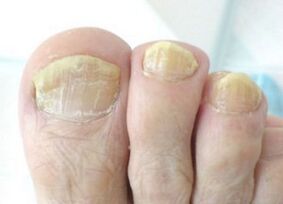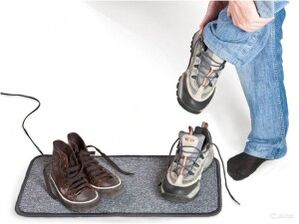Not everyone knows what the nail fungus looks like.In this regard, not every sick person understands when to see a doctor.If you notice signs of nail fungus, you should also determine at which stage the disease is and then contact a specialist immediately.
Symptoms of the disease
The first symptoms of fungi on the legs or arms are usually not as noticeable.Most often it is a small nail lesion.The lateral edges of the plate, as well as the free edge, begin to turn yellowish.The presence of the disease can also be recognized due to the lack of transparency of the nail at the base.
Sometimes you can see a gap between the recording and the bed itself.The reasons for its formation are the accumulation of fungal pathogens, as well as a number of other germs.These types of lesions are called distal-lateral fungal form.

In addition, the fungus of the hands or feet is complemented by hyperkeratosis located under the nails.This name implies the phenomenon when the nail begins to respond to the presence of a fungus by keratinization of the bed itself.The deeper the fungus penetrates the plate, the more the nails or nails of the nails thicken.
The last stage of this form is the defeat of the entire nail as a whole.Also, the matrix begins to participate in the process - this is where the nail begins to grow.Lamelar dystrophy occurs.
In addition, the symptoms of the fungus are exacerbated.Nail damage begins with small white spots.Over time, the species of these spots become more diverse and extensive.In addition, such symptoms can be recognized due to loose, rough nails.Easy to expose by scraping.However, this form is not on the hands.It is suitable for the first finger.
Symptoms of the next form of infection - proximal subbungal - are lesions of the pillow that becomes red.Then the tissues that are located around the nails and nails of the nails begin to swell and shine, and then the shape changes.The result will be the separation of the cuticle from the plate.
Everyone is afraid to find a sponge within themselves because it is dangerous because the next stage is degenerative changes in the nails.The first symptoms of this form are uneven.They are easy to recognize;They look like uneven channels throughout the nail.If the disease is completely neglected, you can completely lose a nail on your hands or feet.
The most dangerous fungus is in the overall dystrophic form.This is the most used disease.The nail (if saved) looks gray in color as well as thickening.The main symptom is complete or partial destruction of the plate.
We are fighting the scourge

Before you start treating fungi on the hands and feet, you should minimize the negative impact from the outside.It is advisable to find the reasons why the fungus of the hands or feet appears and eliminates them.Most often there are four reasons:
- Frequent exposure to a warm and humid environment.The point is that you need to dry your shoes, especially during the Demi season when they are constantly wet.Socks and socks should only be selected from natural materials that will not create problems with thermal and air exchange.
- Often the causes of the fungus of the hands and feet are hidden in poor immunity.It is enough to walk barefoot on the floor to stick to you the infection.
- Frequent nail extensions are also among the most common causes of onychomycosis.It is advisable not to repeat the procedure more than once every six months.
- Any analysis will show that the most staggering fungus is active spores.They can penetrate the hollows between the toes and the toes, remaining sleepy and then start growing sharply.This type of fungus is found in public places.
Even if you notice the first symptoms of fungi described above, you should not start self-medication.You need to go to a specialist who will analyze.Most often, a scraping test is performed to check the nails and nails of the nails for the presence of fungi.This analysis is performed in an alkaline environment where the presence of mycelium is checked under a microscope.
Only after the test shows a positive result can treatment begin.The fact is that the first signs of fungi of the hands and feet are not at all fungi and may have completely different reasons.For example, problems with the internal organs also have a negative effect on the nails.Then a more brief analysis will be required, which most often involves a biochemical blood test.

To determine the causes of the sponge, doctors recommend analyzing the etiology of microorganism.This analysis is performed within three weeks, during which the respective crop is grown.Although there are now modern techniques that allow the fungus to be analyzed to determine the cause of its formation.
Frequent species
There are three most popular species among all the fungi of the hands and feet.The first is the epidermophitosis.We are talking about a fungal disease that affects not only the nails and nails of the nails, but also the skin around them.Most often you can find this type of fungus in a bathroom or fitness.
How are nail fungus transmitted, do you ask?Everything is quite prosaic.These are common hygiene products, linen, oil, mats and other sports equipment and even thermometers.Most often, this type of fungus is found on the feet of men.It seems less often on the hands due to the lack of excessive sweating.
Trichophytosis of the legs is also very common.This is due to the fact that the disease has a high level of contagion.It is also transmitted through objects used by a sick person, including sports equipment.It is extremely rare for children to be affected by these types of fungi.
Most often, young men are at risk, but the percentage is even higher among the adult population.Often this disease can be found in miners or workers in hot -type workshops.In Europe, this disease often receives the "title" of the "foot of the athlete".This type of fungus does not occur on the hands.
The third most common option is candidiasis.It is also located on the legs;Usually it does not reach the hands.The greater part of this type of mushrooms are conditionally pathogenic, therefore, they are present in every person without causing illness.However, with reduced immunity, their pathogenicity can be observed.In addition, they can enter the body from unwashed hands after shared objects, as well as fermented dairy products.
In general, these are the main types of mushrooms that you need to be careful in public places.Most often, the disease protection is quite simple.Use only your personal belongings.Be sure to carry slippers in the showers or swimming pool and always visit a specialist if you suspect a sponge.Do not try to self -heal or self -diagnose.Even an experienced doctor needs a laboratory test to be completely sure.


















